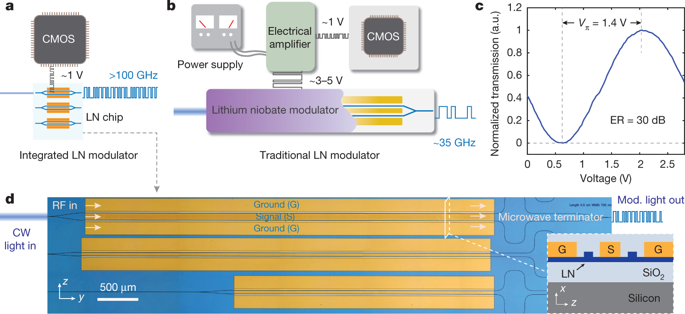Our official English website, www.x-mol.net, welcomes your
feedback! (Note: you will need to create a separate account there.)
Integrated lithium niobate electro-optic modulators operating at CMOS-compatible voltages
Nature ( IF 50.5 ) Pub Date : 2018-09-24 , DOI: 10.1038/s41586-018-0551-y Cheng Wang , Mian Zhang , Xi Chen , Maxime Bertrand , Amirhassan Shams-Ansari , Sethumadhavan Chandrasekhar , Peter Winzer , Marko Lončar
Nature ( IF 50.5 ) Pub Date : 2018-09-24 , DOI: 10.1038/s41586-018-0551-y Cheng Wang , Mian Zhang , Xi Chen , Maxime Bertrand , Amirhassan Shams-Ansari , Sethumadhavan Chandrasekhar , Peter Winzer , Marko Lončar

|
Electro-optic modulators translate high-speed electronic signals into the optical domain and are critical components in modern telecommunication networks1,2 and microwave-photonic systems3,4. They are also expected to be building blocks for emerging applications such as quantum photonics5,6 and non-reciprocal optics7,8. All of these applications require chip-scale electro-optic modulators that operate at voltages compatible with complementary metal–oxide–semiconductor (CMOS) technology, have ultra-high electro-optic bandwidths and feature very low optical losses. Integrated modulator platforms based on materials such as silicon, indium phosphide or polymers have not yet been able to meet these requirements simultaneously because of the intrinsic limitations of the materials used. On the other hand, lithium niobate electro-optic modulators, the workhorse of the optoelectronic industry for decades9, have been challenging to integrate on-chip because of difficulties in microstructuring lithium niobate. The current generation of lithium niobate modulators are bulky, expensive, limited in bandwidth and require high drive voltages, and thus are unable to reach the full potential of the material. Here we overcome these limitations and demonstrate monolithically integrated lithium niobate electro-optic modulators that feature a CMOS-compatible drive voltage, support data rates up to 210 gigabits per second and show an on-chip optical loss of less than 0.5 decibels. We achieve this by engineering the microwave and photonic circuits to achieve high electro-optical efficiencies, ultra-low optical losses and group-velocity matching simultaneously. Our scalable modulator devices could provide cost-effective, low-power and ultra-high-speed solutions for next-generation optical communication networks and microwave photonic systems. Furthermore, our approach could lead to large-scale ultra-low-loss photonic circuits that are reconfigurable on a picosecond timescale, enabling a wide range of quantum and classical applications5,10,11 including feed-forward photonic quantum computation.Chip-scale lithium niobate electro-optic modulators that rapidly convert electrical to optical signals and use CMOS-compatible voltages could prove useful in optical communication networks, microwave photonic systems and photonic computation.
中文翻译:

在 CMOS 兼容电压下运行的集成铌酸锂电光调制器
电光调制器将高速电子信号转换为光域,是现代电信网络 1、2 和微波光子系统 3、4 的关键组件。它们也有望成为新兴应用的构建模块,例如量子光子学 5、6 和非互易光学 7、8。所有这些应用都需要芯片级电光调制器,其工作电压与互补金属氧化物半导体 (CMOS) 技术兼容,具有超高的电光带宽和极低的光损耗。由于所用材料的固有局限性,基于硅、磷化铟或聚合物等材料的集成调制器平台尚不能同时满足这些要求。另一方面,铌酸锂电光调制器,作为数十年来光电行业的主力军,由于铌酸锂微结构化困难,集成片上技术一直具有挑战性。当前一代的铌酸锂调制器体积大、价格昂贵、带宽有限且需要高驱动电压,因此无法发挥材料的全部潜力。在这里,我们克服了这些限制并展示了单片集成铌酸锂电光调制器,该调制器具有与 CMOS 兼容的驱动电压,支持高达每秒 210 吉比特的数据速率,并且片上光损耗小于 0.5 分贝。我们通过设计微波和光子电路以同时实现高电光效率、超低光损耗和群速度匹配来实现这一目标。我们的可扩展调制器设备可以为下一代光通信网络和微波光子系统提供经济高效、低功耗和超高速的解决方案。此外,我们的方法可以导致大规模超低损耗光子电路可在皮秒时间尺度上重新配置,从而实现广泛的量子和经典应用 5,10,11 包括前馈光子量子计算。芯片级锂铌酸盐电光调制器可快速将电信号转换为光信号并使用与 CMOS 兼容的电压,在光通信网络、微波光子系统和光子计算中证明是有用的。
更新日期:2018-09-24
中文翻译:

在 CMOS 兼容电压下运行的集成铌酸锂电光调制器
电光调制器将高速电子信号转换为光域,是现代电信网络 1、2 和微波光子系统 3、4 的关键组件。它们也有望成为新兴应用的构建模块,例如量子光子学 5、6 和非互易光学 7、8。所有这些应用都需要芯片级电光调制器,其工作电压与互补金属氧化物半导体 (CMOS) 技术兼容,具有超高的电光带宽和极低的光损耗。由于所用材料的固有局限性,基于硅、磷化铟或聚合物等材料的集成调制器平台尚不能同时满足这些要求。另一方面,铌酸锂电光调制器,作为数十年来光电行业的主力军,由于铌酸锂微结构化困难,集成片上技术一直具有挑战性。当前一代的铌酸锂调制器体积大、价格昂贵、带宽有限且需要高驱动电压,因此无法发挥材料的全部潜力。在这里,我们克服了这些限制并展示了单片集成铌酸锂电光调制器,该调制器具有与 CMOS 兼容的驱动电压,支持高达每秒 210 吉比特的数据速率,并且片上光损耗小于 0.5 分贝。我们通过设计微波和光子电路以同时实现高电光效率、超低光损耗和群速度匹配来实现这一目标。我们的可扩展调制器设备可以为下一代光通信网络和微波光子系统提供经济高效、低功耗和超高速的解决方案。此外,我们的方法可以导致大规模超低损耗光子电路可在皮秒时间尺度上重新配置,从而实现广泛的量子和经典应用 5,10,11 包括前馈光子量子计算。芯片级锂铌酸盐电光调制器可快速将电信号转换为光信号并使用与 CMOS 兼容的电压,在光通信网络、微波光子系统和光子计算中证明是有用的。





















































 京公网安备 11010802027423号
京公网安备 11010802027423号